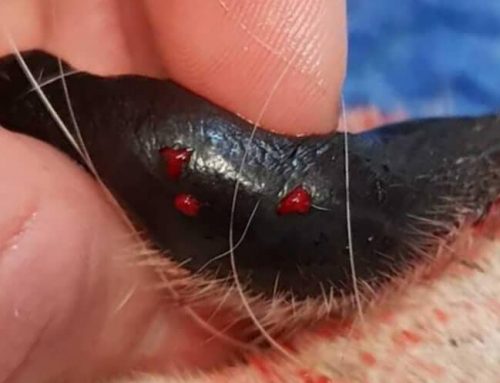When Is The Best Age To Desex A Dog?
One of the first questions many new dog owners have for their veterinarian is: “when is the best age to spay or neuter my dog?”
It is a question that is fraught with controversy and conjecture, but now we have the evidence to provide an informed answer for you all.

Video: Dr Leigh Explains The Spay/Neuter Research
Dr Leigh discusses the data generated from the Davis study in the following video.
Latest Research On Spay And Neuter Timing
The latest research by the University of Davis, California published in July 2020 advises that the best age to desex a dog is highly dependent on the breed as well as the sex of the dog.
For small dog breeds (those under 15kg) the consensus is that the majority can be desexed around 6 months of age.
There are specific breeds where the recommendation is to desex closer to 1 year of age and for some high cancer-risk breeds or breeds with increased risks of bone developmental issues or urinary incontinence, the recommendation is to spay or neuter after 2 years of age.
Let’s start with a disclaimer – it’s wise to remember that research in veterinary medicine is constantly evolving.
What is the best available advice today, may well be considered obsolete within the year.
Glossary Of Terminology Used
Neutering/Castration: removal of a male dog’s testicles and epididymides.
Spaying/Spaying: removal of a female dog’s sex organs, usually ovaries and uterus, but could be just the ovaries or just the uterus.
Desexing: removal of an animal’s sex organs.
Gonadectomy: removal of the gonads or sexual organs
Female sex hormones: oestrogen and progesterone
Male sex hormone: testosterone
Often the terms desexing, neutering, spaying/spaying are used interchangeably to mean the removal of the sex organs.
Heat Cycle: the period of time that a female intact dog is sexually receptive and can become pregnant.
Puberty: the age of sexual maturity.

The primary reason for desexing dogs at 6months of age is to prevent them from reproducing.
It’s important to be mindful of population control.
Globally, there is an overpopulation of unwanted dogs, that puts a high burden on society and of course is not great for these dogs and their health.
One way to assist population control is to desex intact dogs when they enter an animal shelter environment regardless of age, prior to them going to their new home.
This lowers the risk that a new owner, may not do the right thing by that dog.
Other benefits of desexing at 6months of age include reducing the effects of sexual behaviours such as flagging in bitches and urine marking in male dogs.
Many dogs become sexually mature between 6mths and 10mths so it makes perfect sense to desex before this occurs.
In our article describing the pros and cons of desexing, we go into greater detail about how spaying and neutering have been shown to reduce the risk of some diseases such as mammary cancer in the bitch and prostate cancers in the dog.
Desexing can be performed as early as 6-8 weeks of age with very few surgical or anaesthetic complications.
How Was The University Of Davis Study Performed?
This was a retrospective study that followed dogs over a period of 15 years who visited the University of Davis, Veterinary Medical Teaching Hospital (VMTH).
35 dog breeds were included in the study: Golden Retriever, Labrador Retriever, German Shepherd Dog, Australian Cattle Dog, Australian Shepherd, Beagle, Bernese Mountain Dog, Border Collie, Boston Terrier, Boxer, Bulldog, Cavalier King Charles Spaniel, Chihuahua, Cocker Spaniel, Collie, Corgi (Pembroke and Cardigan combined), Dachshund, Doberman Pinscher, English Springer Spaniel, Great Dane, Irish Wolfhound, Jack Russell Terrier, Maltese, Miniature Schnauzer, Pomeranian, Poodle-Miniature, Poodle-Standard, Poodle-Toy, Pug, Rottweiler, Saint Bernard, Shetland Sheepdog, Shih Tzu, West Highland White Terrier, and Yorkshire Terrier.
The study chose to examine types of cancer that previous studies had found could be affected by neuter status. These included:
- lymphoma/lymphosarcoma (LSA),
- hemangiosarcoma (HSA),
- mast cell tumours (MCT),
- osteosarcoma (OSA).
In addition, mammary cancer (MC), pyometra (PYO), and urinary incontinence (UI) were examined in female dogs.
The orthopaedic diseases examined in this study included:
- cranial cruciate ligament tears or rupture (CCL),
- hip dysplasia (HD)
- elbow dysplasia (ED)
All of the above diseases were examined with regard to dogs neutered in one of the age periods of:
- <6 months,
- 6–11 months,
- 1 year (12 to <24 months)
- or 2–8 years,
- or left intact.
The diseases were tracked until the dogs were last seen at the hospital, or through until the dog was 11 years of age if seen past their 12th birthday.
Some Dogs Benefit From Delayed Spaying And Neutering
The results of this study follow.
Rather than go through every dog breed and sex, I’m going to outline only those that showed significant differences in the incidence of either joint disease, cancer or urinary incontinence (that’s in females) so you don’t need to go hunting for it.
If a breed isn’t mentioned in the list below, that is an indication that in this study, there were no significant health effects on the timing of desexing.
For mixed breed dogs, follow the advice for the breed it most likely resembles.
Essentially you can spay or neuter at a time that suits you and the dog best – usually around that 6mth of age time.
Golden Retriever
Sadly, for females – the risk of cancer is high in all intact females regardless of age.
According to this study, the incidence of cancer for those that are spayed is 2-4% higher than those that are intact.
The recommendation for female golden retrievers is to leave them intact for as long as possible, or perform the spay surgery at 2 years and watch them closely for cancer (twice yearly vet exams is recommended by oncology experts).
For male golden retrievers – their risk profile for both joint diseases and cancer has a high enough incidence rate to recommend neutering at around 1 year of age.
Labradors
For males to have some protection from joint disorders, the recommendation is to neuter after 6mths.
For females, the recommendation is to spay after one year to provide protection against joint disorders.
Boxers
This breed is at high risk of cancer. To lower these risks, the recommendation for both sexes is to perform desexing surgery after 2 years of age.
Cocker Spaniel
This is another high-risk cancer breed, however, it appears the risk is only for females. Hence, the recommendation is to spay females after 2 years of age.
Collie

Rough coat collie dog.
There is a slightly increased risk of cancer for females collie dogs only.
To lower this risk they should be desexed after 1 year of age.
Dobermans
While Dobermans have traditionally been thought of as a high-risk cancer breed, in this study it was joint disease problems that were most linked with desexing.
The guidelines recommend desexing males after 1 year and females after 2 years to assist bone development and help decrease issues such as cruciate ligament rupture.
Springer Spaniels and West Highland White Terriers

West Highland White Terrior puppy.
To lower the incidence of urinary incontinence it is recommended that females of both these breeds are spayed after 1 year old.
German Shepherd
Both male and female dogs of this breed need to be desexed after 2 years.
This is to help prevent an increased incidence of joint disease.
Bernese Mountain Dog
The male of this giant breed is prone to an increase in joint disease if desexed prior to 2 years.
Great Danes
Surprisingly, both sexes of this giant breed are at no greater risk or joint disease or cancer if desexed early around 6months of age.
However, due to a high level of musculoskeletal disorders that vets see in this breed, it is recommended to desex after 1 year.
This however is not related to sex hormones.
Wolfhound
Interestingly the female has a similar recommendation to the Great Dane: desex at any time however after 1 year is better.
The male Wolfhound, however, has a higher incidence of cancer if neutered before 2 years of age.
Saint Bernard

These giant breeds were not shown to have any age effects of desexing and can be spayed after 6mths.
Shetland Sheepdog
The female of this breed is prone to developing urinary incontinence if spayed prior to 2 years of age.
Shih Tzu
Interestingly the female should either be spayed very young before 6months or after 2 years to lower their incidence of cancer.
Confounding Factors In This Study
In summary, with most breeds or sexes, desexing can be performed without concern of age, at least with regard to the joint disorders or cancers covered in this study.
Of course, individual factors absolutely must be taken into account.
That’s why it’s always best to discuss with a veterinarian.
This paper is a fantastic guide for the breeds that it studies.
But as the years go by and more research is performed we may find changes to some of the recommendations we may currently have.
Part of being a good pet parent is to find out exactly what diseases your dog’s breed is most at risk for.
If purchasing a particular breed, ask the breeder for information about the health status of their family line.
- Is cancer prevalent?
- Do any of the dogs suffer from an orthopaedic disease?
We also need to remember that there are other confounding factors that weren’t taken into consideration.
One important one being body weight or body condition.
We know that overweight dogs are more prone to many joint problems and some cancers.
We are always learning in veterinary medicine.
More data is coming from studies but like many things, there is no clear cut fact.




Do you have a recommendation as to what age is best to desex a french bull dog? I see this breed is not listed in the “frontiers” paper. thanks!
Why would you not include all the results of the different breeds. My Australian Shepard is 14 monthes old and in trying to see
Hi
We summarised the findings. According to the attributes measured in this study, an Australian shepherd can be desexed at any time – we would recommend around 7-8months of age.
Shetland Sheepdogs [bitches in general]. i have seen statistics [U Cornell] that say that after an unspayed female has had two heats her chance of developing mammary gland tumors is 25% — this does not mention anything about it — it’s a general statistic, not breed specific but I’m surprised to see no mention of it.
Your information is very helpful to both me and my vet. I have an English Cocker Spaniel. In your study, you refer to “Cocker”. Does what you say apply to both English and American Cockers? Our female pup is 7 months. The breeder suggested waiting until she is 18months. Your study, if it applies to an English Cocker suggests 2 years. I would be grateful for clarification.